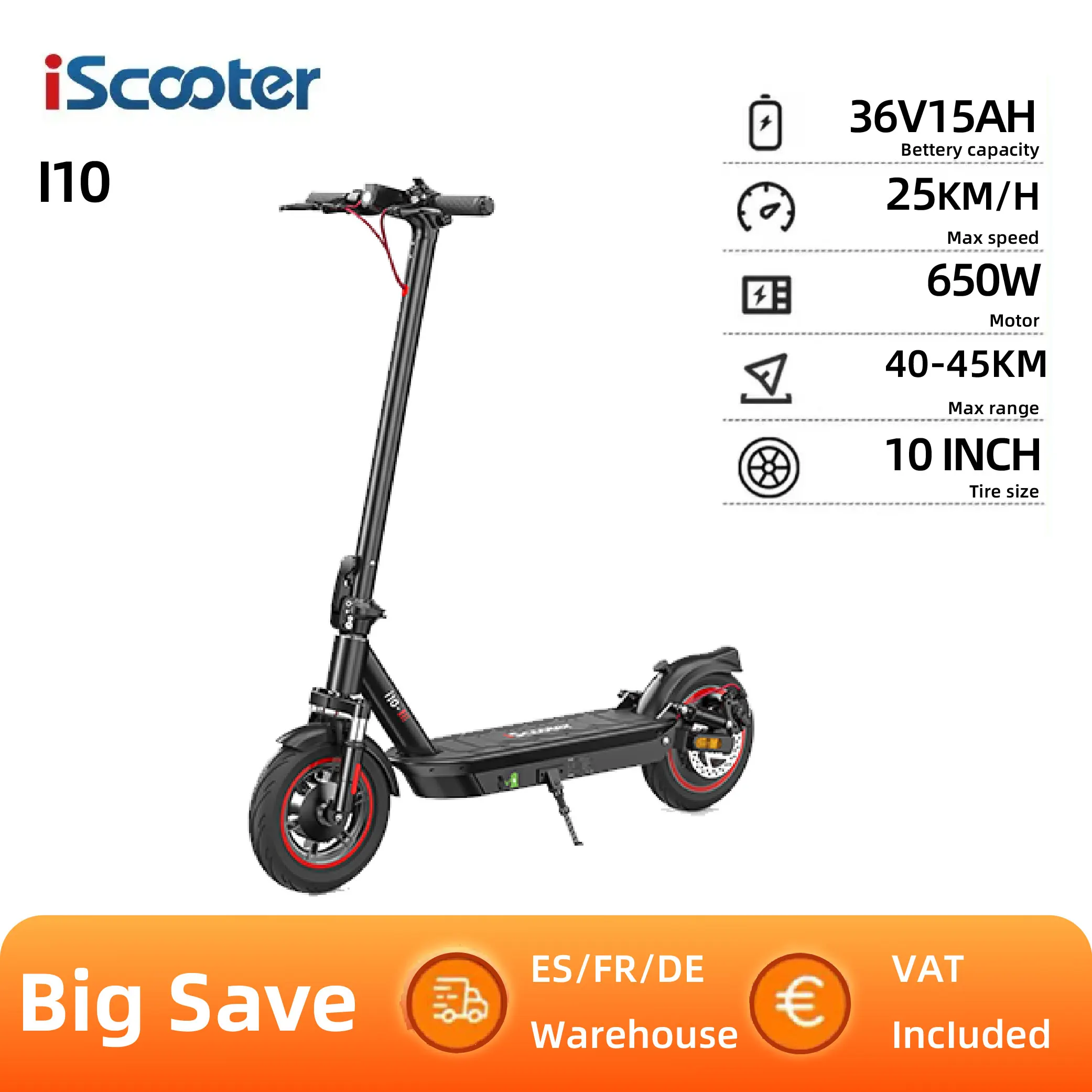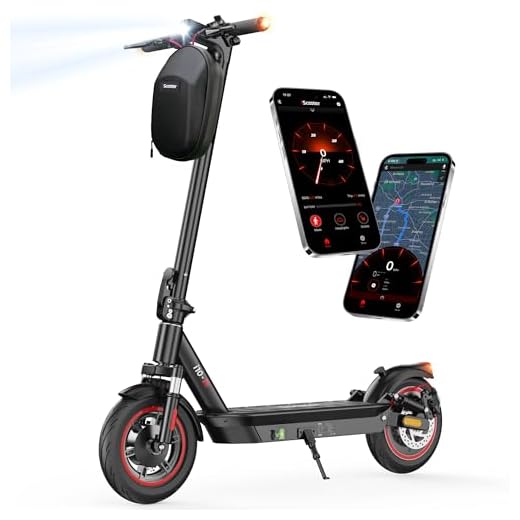If you want a commuter scooter that feels stable at speed yet stays manageable on sidewalks and stairwells, the iScooter i10 sits in a sweet spot. In this iScooter i10 review, I break down what the scooter actually feels like to live with day-to-day—how it accelerates, brakes, folds, and holds up over broken pavement. If you’re considering a lighter, simpler alternative from the same family, take a look at the iScooter i8.
Before we dive in, a quick snapshot: the i10 pairs a rear-hub motor with a 36 V (42 V max) 15 Ah battery, runs 10-inch pneumatic road tires, includes dual suspension and a rear disc plus electronic brake, and adds a Bluetooth app with cruise control and zero-start toggle. Those headline claims set expectations; the details below show where it shines and where it compromises.
Key Specifications
The i10’s core specifications are manufacturer-listed. Where helpful, we include both imperial and metric.
General
| Item | Details |
|---|---|
| Model | iScooter i10 |
| Intended use | Urban/commuter, paved roads |
| Rider max load | 264 lb (120 kg) |
| Water resistance | IP54 (splash-resistant) |
| Wheel type/size | 10-in pneumatic road tires (25.4 cm) |
| Drive | Rear-wheel drive |
Performance & Power
| Item | Details |
|---|---|
| Motor | Rear hub, peak 650 W |
| Top speed | Up to 25 mph (40 km/h) |
| Ride modes | 4 selectable modes |
| Throttle | Thumb press |
Charging & Electrical
| Item | Details |
|---|---|
| Battery | 36 V nominal (42 V max), 15 Ah ≈ 540 Wh |
| Claimed range | Up to 28 mi (45 km) |
| Charge time | ~6–8 hours |
| Battery management | BMS (over-charge/discharge protection) |
Build & Dimensions (include folded dimensions)
| Item | Details |
|---|---|
| Frame | Aluminum alloy |
| Scooter weight | ~44 lb (20 kg) |
| Unfolded | ~45.2 × 19 × 47.2 in (115 × 48.5 × 120 cm) |
| Folded | ~45.2 × 19 × 21.2 in (115 × 48.5 × 54 cm) |
| Foldable handlebars | No |
| Adjustable stem | No |
Safety & Control
| Item | Details |
|---|---|
| Primary brakes | EBAS/EABS electronic brake (front motor) |
| Rear brake | Rear disc brake (mechanical) |
| Suspension | Front & rear double shock absorbers |
| Lighting | LED headlight and tail/brake light |
| Controls | Lever-actuated braking; thumb throttle |
Features & Extras (includes Cruise Control)
| Item | Details |
|---|---|
| Bluetooth app | Lock/unlock, gear selection, zero-start toggle, max speed limit, lights |
| Cruise control | Yes (in-app activation and on-scooter control) |
| Display | Multi-function handlebar display (speed, mode, battery) |
| Kickstand | Integrated side stand |
Warranty & Compliance
| Item | Details |
|---|---|
| Warranty | Stated 12-month manufacturer warranty (region-dependent) |
| Ingress | IP54 (splash-resistant) |
Design & Build Quality
The iScooter i10 presents as a classic commuter: matte alloy frame, a straight stem, and clean cable routing into the folding joint. The deck has enough fore-aft room for a natural stance, and the slightly tapered tail keeps heel strikes rare. Because the scooter weighs around 44 lb (20 kg), it feels more planted than ultra-light models but still manageable when you need to carry it up a flight of stairs. The latch geometry engages with an audible click, and the tube lock resists micro-play well once you’ve tightened it properly.
Fit and finish are consistent for the category. Panel gaps are tight; the deck striping aligns; and the display integrates flush with the handlebar. Grips are foam, which many riders like for comfort, though they do absorb sweat and can show wear sooner than rubber. Cabling along the stem is sheathed, so it won’t snag on jackets or backpacks during quick turns. The rear fender is braced and sits high enough to avoid rubbing the tire while still catching spray.
Finally, the lighting package is practical. The headlight sits high on the stem so it casts a useful beam down the road rather than onto your front tire. The tail/brake light is bright enough to be seen at dusk, and you can toggle lights at the bar or via the app. As for IP54 resistance, it’s fine for damp commutes and puddle splashes, but it is not for submersion or heavy downpours; wipe the scooter dry after wet rides to protect bearings and bolts.
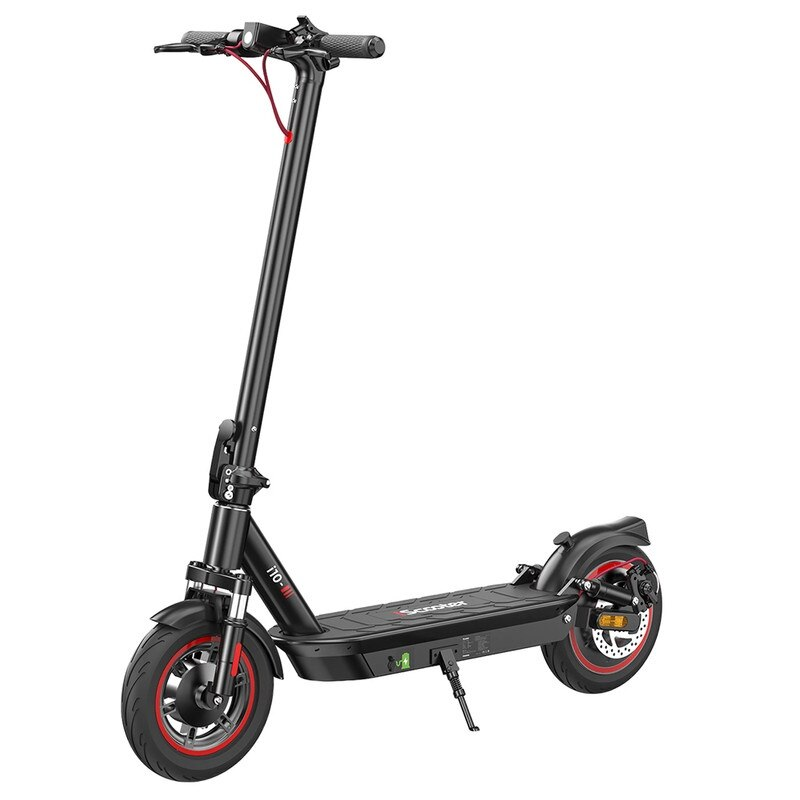
Motor, Power & Acceleration
With a peak 650 W rear hub, the i10 launches with a confident push. In Eco, starts are gentle and predictable, which keeps new riders comfortable. Step up to the higher modes, and throttle response gets snappier without feeling twitchy. Because the motor sits at the back, traction under power is solid; the tire carries weight, and the rear end digs in when you lean forward and roll on.
From a standstill, you can choose zero-start or kick-to-start. Zero-start is convenient at traffic lights; kick-to-start prevents accidental throttle bumps from sending the scooter forward when you’re not ready. Both are accessible in the app. The midrange pull is the i10’s sweet spot. It doesn’t surge; it builds speed steadily and holds it, which is exactly what you want for steady 15–20 mph (24–32 km/h) stretches.
On short, moderate hills around 7–8% grade, expect speed to dip but not collapse. If you enter with a little momentum and keep your stance athletic, it will crest neighborhood climbs without drama. On longer grades, you’ll notice a gradual roll-off; switching down a mode and letting the scooter settle can keep motor and controller temps happier. As always, rider weight, tire pressure, and wind play a role in real-world climbing.
Noise is low. You’ll hear the whirr of the hub and a faint controller note under load, but wind noise and tire hum dominate above 15 mph (24 km/h). Mechanical rattle is minimal on a well-tightened unit; check that stem latch and axle hardware at least once a month.
Battery, Range & Efficiency
The pack is 36 V nominal (42 V max), 15 Ah—about 540 Wh. That capacity anchors the scooter’s calm feel over distance. On flat, mixed-speed commutes with a 170–190 lb (77–86 kg) rider, plan for 12–18 miles (19–29 km) of no-anxiety range if you ride briskly, or low-20s miles if you cap speeds and keep starts smooth. In cooler weather, expect a reduction; lithium packs deliver less at lower temperatures.
Charging from low to full takes around 6–8 hours with the stock charger. The BMS handles over-charge and over-discharge protection, which is industry standard, but you still extend pack life by stopping short of 100% for daily rides. A simple routine works well: charge to ~90% the night before a commute, top off for long weekend rides, and store at ~50–70% if the scooter will sit a week or more.
Efficiency improves when you run proper tire pressure, keep your deck clear of mud buildup, and avoid constant full-throttle sprints. Cruise control helps with that last point; holding the same speed cuts the constant surge-and-coast cycle that wastes energy. On hills, it’s smarter to let speed drop a few mph than to insist on maximum output the entire ascent.
Ride Quality, Handling & Comfort
The i10’s two big comfort wins are its 10-inch pneumatic tires and the dual-shock layout. Air tires add compliance on their own, softening square-edged cracks and tamping down chatter that solid tires transmit straight into your hands. The spring shocks do the rest. Over patched city asphalt, the scooter keeps contact and stays composed, so your hands don’t tense up to fight harsh impacts. That reduces fatigue, which matters on commutes.
Steering is stable. The deck is long enough to stagger your feet and shift weight for corners. At 44 lb (20 kg), the scooter has some rotational inertia in quick S-bends, but that translates into reassuring straight-line stability at higher speeds. There’s no obvious speed wobble if tires are balanced and the stem latch is snug. In rain, reduce pressure a touch within the recommended range for a bigger contact patch, and brake sooner to avoid slips.
Handlebar height suits riders in the ~5’6″–6’1″ (168–185 cm) range well. Taller riders can still find a neutral stance by shifting rearward on the deck and letting elbows bend. Foam grips are comfy and take the buzz out of cobbles, though heavier sweaters may prefer swapping to rubber grips for durability.
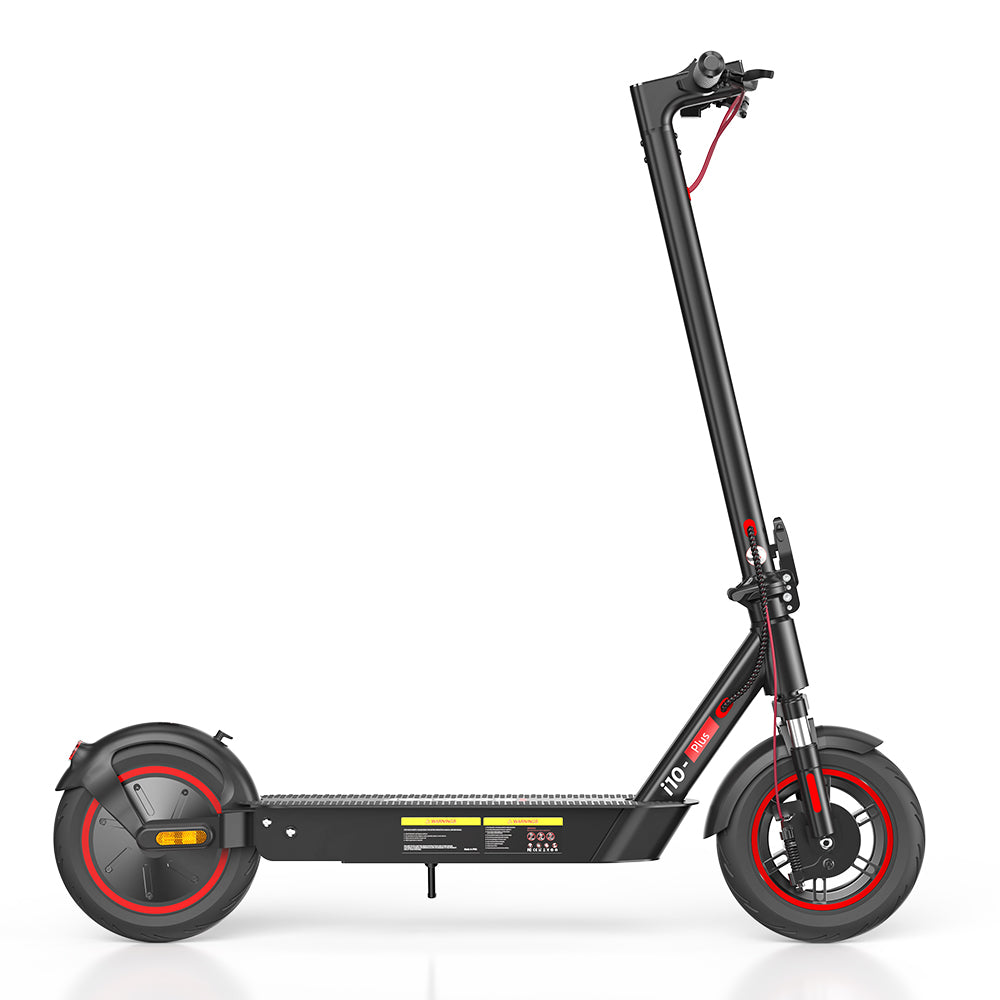
Braking & Safety Features
Braking blends the EBAS/EABS electronic brake with a mechanical rear disc. On light lever pulls, you feel the electronic system drag speed down smoothly and recover a little energy; push harder, and the rear disc adds bite. Modulation is predictable, and the rear bias keeps the scooter planted. Panic stops are straight, especially if you keep weight low and back.
The electronic system also adds a layer of redundancy. Even if the rotor is wet, you still have motor braking to shave speed before the caliper bites. That helps on rainy mornings when steel takes a moment to dry. In daily riding, it’s smart to keep braking consistent—firm squeeze, then release slightly as you near the stop line—to avoid jolting a passenger car behind you.
Lighting is straightforward: a stem-mounted headlight you can aim and a bright tail/brake light. Use the app to ensure the brake flash is enabled if available, and add a helmet light if you ride at night often. As always, braking distance depends on tire pressure, load, and surface conditions; ride with margin.
Portability & Daily Usability
At ~44 lb (20 kg), the i10 is a “carryable” commuter rather than a featherweight. The folded size—about 45.2 × 19 × 21.2 in (115 × 48.5 × 54 cm)—slides into a car trunk or under a desk with a bit of planning. The latch is simple: drop the stem, secure the hook, and you’re set for an elevator ride. Because the handlebars don’t fold, the folded width is fixed at the bar span; that’s easier to grab with two hands, but it won’t slip through very narrow gaps as a folded-bar scooter would.
Day to day, the kickstand is sturdy and the deck clears most curb cuts. The display is readable in daylight, and mode switching feels immediate. A simple routine helps: power on, quick brake test at low speed, check for play at the stem, and glance at tire sidewalls. These 10-second checks keep the scooter feeling tight and safe.
If you commute by train or bus, the weight remains the main trade-off. It’s not punishing, yet if you face long platform walks or multiple stair flights, plan to shoulder it only occasionally.
Features, App & Extras
The app is the i10’s sleeper feature. It lets you lock the motor, toggle zero-start, set a maximum speed limit, switch units, control lights, and engage cruise control. The lock isn’t a physical lock—always use a proper U-lock or cable for real security—but the motor lock deters casual roll-offs. Cruise control works as expected: hold a steady speed, wait for the beep, and release the throttle; it cancels the moment you tap the brake or blip the throttle.
You can also change riding modes and check battery status on your phone, which is nice when you park the scooter in a hallway and want to confirm charge level before the trip home. Because the app uses Bluetooth, range is short; stand within a few meters for reliable control. If you’re sharing the scooter within a household, consider creating a routine for who has app control to avoid conflicting settings.
One more note: the app is helpful for fine-tuning the throttle. Some riders prefer a gentler start in wet conditions or crowded areas, and the zero-start toggle offers that.
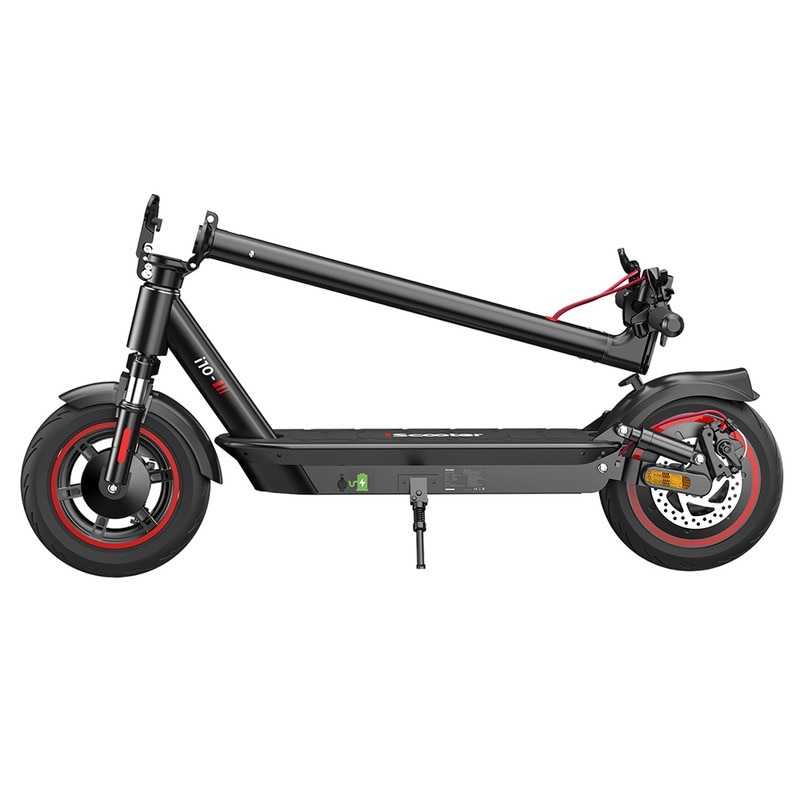
Charging Experience & Maintenance
Charging is plug-and-wait, with a 6–8 hour window from low to full. The LED on the brick flips from red to green when done. The charge port has a rubber cap; keep it sealed when not charging to keep splashes out. If you regularly ride in rain, wipe the port area and fold joint to prevent corrosion.
Maintenance is straightforward:
- Tires & pressure: Check weekly; under-inflation invites pinch flats and dull handling, while over-inflation reduces comfort and grip.
- Brakes: Inspect the rear disc pad wear monthly; adjust cable slack at the barrel so the lever engages early without dragging.
- Bolts & latch: Stem latch and axle hardware deserve a quick check every couple of weeks. A small bit of thread locker on non-adjustment bolts helps.
- Suspension: Wipe the shock rods clean; grit shortens seal life.
- Battery care: Avoid leaving the pack at 0% or 100% for long periods. For storage, 50–70% state of charge is ideal.
Do these basics, and the scooter remains tight, quiet, and efficient well past the first season.
Who the iScooter i10 Is For
Choose the i10 if your commute mixes bike lanes, parks, and short road stretches and you value a stable, cushioned ride. The battery capacity fits medium daily distances and weekend errand loops without mid-day charging. If you weigh under 220 lb (100 kg), live with rolling hills, and prefer a calmer throttle map to sharp surges, this model suits you well.
If you need ultra-light carrying weight, frequent third-floor walks, or maximum hill power, you might want a different configuration (lighter chassis or higher-power hub). Likewise, if you demand folding handlebars for tight closet storage, note that the i10’s don’t fold.
Value for Money & Verdict — iScooter i10 review
The iScooter i10 blends the features most commuters actually use—air tires, dual shocks, a rear disc plus electronic brake, an app with cruise and zero-start, and a battery that covers typical city miles—without over-promising on extreme performance. It rides with composure, brakes with confidence, and keeps controls simple.
The compromises are honest: a 44 lb (20 kg) frame you feel on stairs, a fixed handlebar width when folded, and hill performance that favors steady riders over sprinters. Yet for everyday travel at legal urban speeds, the i10 feels balanced and reassuring. This review lands on a clear conclusion: if you want comfort and calm control more than raw power, the i10’s package makes sense.
Pros & Cons
Pros
- Stable, confidence-building handling at 15–20 mph (24–32 km/h)
- 10-inch pneumatic tires + dual shocks smooth broken asphalt
- Rear disc + electronic brake blend for predictable stops
- Practical 36 V/15 Ah battery with realistic commuter range
- App control with lock, zero-start toggle, and cruise control
- Clear display and straightforward mode switching
- IP54 splash resistance helps in mixed weather
Cons
- ~44 lb (20 kg) weight is noticeable on stairs
- Handlebars don’t fold, so folded width stays wide
- Foam grips wear faster than rubber in daily use
- Hill performance is solid but not sporty under heavy riders
- Rear-biased braking requires good weight shift on slick roads
- No adjustable stem; very tall riders may want more bar height
Price
FAQs
How fast does the iScooter i10 go?
Up to 25 mph (40 km/h) in the highest mode. Always obey local speed rules and ride with margin.
What is the real-world range I should expect?
Expect teens to low-20s miles (19–35 km) for mixed rides, with 28 mi (45 km) possible at gentler speeds and lighter loads. Temperature and terrain matter.
Does the i10 have cruise control?
Yes. You can enable cruise control via the app and engage it during rides by holding a steady speed. It cancels with brake or throttle input.
Is there an app for locking and settings?
Yes. The Bluetooth app handles lock/unlock, zero-start, speed limit, lights, and more. Keep in mind it’s a motor lock, not a physical lock.
What’s the folded size and weight?
About 45.2 × 19 × 21.2 in (115 × 48.5 × 54 cm) and roughly 44 lb (20 kg). Plan for two-hand carries on stairs.
Does the iScooter i10 review address hill climbing?
Yes. On moderate 7–8% grades, it keeps moving with a steady stance and some momentum. For long, steep hills, expect speed to drop as it protects the motor and controller.
What maintenance does it need?
Keep tires properly inflated, check the rear brake and stem latch regularly, and avoid storing the battery fully empty or full for long periods.
Final Thoughts
For riders who value comfort and calm predictability more than peak power, the iScooter i10 delivers. Its pneumatic tires, dual suspension, and blended braking make daily commutes less tiring. Add a practical battery and a genuinely useful app, and you get a scooter that feels thought-through rather than flashy. This review finds the i10’s best version of itself on real city streets, not spec sheets.



